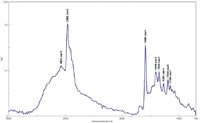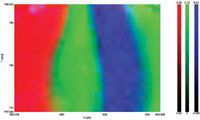Advanced Infrared Imaging for Sample Analysis
The authors look at the ways in which an imaging FT-IR microscope system with an integrated linear array detector can aid in the examination of a wide array of samples.
In recent years, there has been explosive growth in the applications of infrared imaging and the data resulting from imaging systems. From materials research to the imaging of cancer cells and disease as well as uses as a quality control tool for polymers and pharmaceuticals, infrared imaging is being used in virtually every type of laboratory around the globe. As new challenges emerge for the analysis of samples, the infrared imaging system must provide additional capabilities for these types of analyses. An imaging Fourier-transform infrared (FT-IR) microscope system with an integrated linear array detector provides a powerful tool for the examination of a wide array of samples, and combining this flexible imaging system with advanced image-processing software can provide visually relevant data for laboratory scientists.
Fourier-transform infrared (FT-IR) microscope imaging systems can provide a simple spectrum of a very small contaminant in a larger matrix or detailed information about the distribution of the chemical constituents or other types of spatial information (such as the variation and distribution of layers in a polymer laminate). In the past, FT-IR microscopes and imaging systems were the realm of research laboratories or users with extensive experience in IR spectroscopy.
Experimental and Results
All data were collected utilizing an FT/IR-6300 and IRT-7000 microscope (JASCO, Easton, Maryland). The microscope consists of an imaging system that incorporates both single-element mercury-cadmium-telluride (MCT) and multielement linear array detectors with an xyz auto-stage. The single-element MCT detector also can be specified as user-interchangeable, providing the capability to exchange the single-element MCT detector for other spectral range detectors such as an InGaAs or InSb detector for near-IR experiments or even a deuterated tryglycine sulfate (DTGS) detector for use without liquid nitrogen but with an extended mid-IR spectral range. The microscope can incorporate as many as four objectives as well as interchangeable attenuated total reflectance (ATR) objectives. Sample spectra were collected with spectral resolutions ranging from 4 to 16 cm-1 , with various accumulated scans for background and sample spectra, as outlined later. Figure 1 illustrates a video image (left) and infrared mapping image (right) of an ink stain on a reflective metal plate. These data were collected using the IQ mapping function of the IRT-5000/7000 system. A limited mapping of a sample can be accomplished using either the single point or multipoint detectors without movement of the auto-stage. Optical train mirrors before and after the cassegrain objective can be moved to collect data from the full planar area of the cassegrain focus. This function can increase the speed of mapping or imaging data collection or can be used with the manual stage to provide mapping capability without the use of an automated xyz stage. The mapping image is based upon the peak height of the C-H stretching peak of the ink at 2962 cm-1 , the corresponding spectrum illustrated as Figure 2. The spectral data displayed in Figures 1 and 2 were collected using eight scans per pixel at 16-cm-1 resolution using a 12.5 µm x 12.5 µm aperture, with the total area of 200 µm x 200 µm collected in slightly more than 1 min.

Figure 1: Video and infrared images of an ink stain on a metal plate.

Figure 2: Mid-infrared spectrum of ink stain sample displayed in Figure 1.
The infrared spectral image data can be displayed as "false color" image maps based upon peak intensity, calculations of peak height/ratio data, or peak area/ratio data. Additional calculations also can provide images based upon peak shift or full-width at half maximum values. Image data from these various calculations also can be displayed as contour maps, "bird's eye" views of the peak information, and 3-D images to provide image contrast for information purposes. These options are all available in the microscope data processing software (Figure 3). This software interface displays the automatically collected video images as well as individual spectra, image maps, and calculated data for easy interpretation of the collected data. If multipoint data are collected from multiple sample sites, the individual spectra can be selected with the corresponding video images for each sample area. The analysis software is available for use while the data collection is occurring within the data collection package, providing simultaneous operation of the microscope system and analysis of previously collected data. The image data displayed in Figure 3 are obtained from the area around the minting date of a penny coin, the "yellow" image areas due to the skin proteins embedded around the raised metal of the date stamp. The imaging data were collected with the multielement linear array detector using 16 scans at 16-cm-1 resolution per 12.5 µm x 12.5 µm pixel, the total area of 2 mm x 4 mm collected in about 35 min for a total of 50,560 individual spectra.

Figure 3: Microscope data analysis software dialog.

Figure 4: ATR spectral image data collected from a polymer laminate: (a) polyethylene, (b) nylon, and (c) polyvinyl alcohol.
Another example of the data display capabilities is demonstrated in Figures 4 and 5, the ATR spectral images collected from a polymer laminate. The individual spectral images are represented in Figure 4, the image data based upon specific absorption peaks in the polyethylene, nylon, and polyvinyl alcohol components of the laminate. Overlaying the individual images provides the "composite" image outlined within Figure 5, which provides a clear display of the margins of the individual components and any overlap of the spectral data obtained by the ATR mapping experiment. Data from the 68 µm x 44 µm area were collected using the IQ mapping mode, mapping the interior of the Ge ATR element using the linear array detector with 64 spectral accumulations at 8-cm-1 resolution. The 672 spectra of 2.2 µm x 2.2 µm spatial resolution required approximately 8 min for collection of the displayed sample image data.

Figure 5: Composite ATR spectral image data of a polymer laminate: red = polyethylene, green = nylon, blue = polyamide/polyvinyl alcohol.
For the analysis of polymer laminates, information concerning the identity and spatial distribution of the various layers can be of critical importance, verifying the production of the laminate or providing information on a competitive product. Collection of the "line-map" data using a very small aperture can provide the desired information for the laminate layers and their spatial arrangement. Figure 6 outlines the various spectra of a polymer laminate cross-section collected in transmission mode. The 3-D display of the spectra as shown were collected with a 5 µm x 50 µm aperture, using 8-cm-1 resolution and 128 accumulations per spectrum with the single-point MCT detector on the IRT-7000 imaging system. The various spectra in the figure provided identification of the polyethylene, polypropylene, and nylon layers of the laminate as well as the spatial distribution of the individual polymer layers. Individual spectra from the image map were selected and verified with the use of a spectral search library, while the spatial distribution of the laminate layers was determined from cross-section calculations of the significant spectral peaks of each component. The figure demonstrates the different spectra and spatial distribution and can be rotated with the mouse within the microscope analysis software dialog, providing the ability to rapidly visualize features of interest within the image.

Figure 6: 3-D display of line-map spectra for a polymer laminate of five individual layers.
Conclusion
An FT-IR microscope system with a linear array detector can provide infrared imaging data of high quality in a relatively short time frame. The integration of the imaging system with comprehensive analysis software can provide relevant data to the laboratory scientist while providing clear visualization of the imaging results.
Richard A. Larsen is with JASCO, Easton, Maryland. Ken-ichi Akao, Hiroshi Sugiyama, and Jun Koshoubu are with JASCO Corporation, Tokyo, Japan.

AI Shakes Up Spectroscopy as New Tools Reveal the Secret Life of Molecules
April 14th 2025A leading-edge review led by researchers at Oak Ridge National Laboratory and MIT explores how artificial intelligence is revolutionizing the study of molecular vibrations and phonon dynamics. From infrared and Raman spectroscopy to neutron and X-ray scattering, AI is transforming how scientists interpret vibrational spectra and predict material behaviors.
Real-Time Battery Health Tracking Using Fiber-Optic Sensors
April 9th 2025A new study by researchers from Palo Alto Research Center (PARC, a Xerox Company) and LG Chem Power presents a novel method for real-time battery monitoring using embedded fiber-optic sensors. This approach enhances state-of-charge (SOC) and state-of-health (SOH) estimations, potentially improving the efficiency and lifespan of lithium-ion batteries in electric vehicles (xEVs).
New Study Provides Insights into Chiral Smectic Phases
March 31st 2025Researchers from the Institute of Nuclear Physics Polish Academy of Sciences have unveiled new insights into the molecular arrangement of the 7HH6 compound’s smectic phases using X-ray diffraction (XRD) and infrared (IR) spectroscopy.